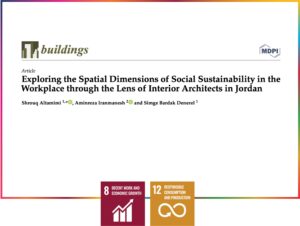
The research, co-authored by a researcher Altamimi from Faculty of Architecture, Near East University, addresses the gap in existing studies by emphasizing the crucial but often neglected aspect of social sustainability in workplace design, specifically focusing on the interior design profession in Jordan. The study argues for the necessity of workplace design guidelines that prioritize parameters intersecting the needs of the twenty-first-century workforce and corporate interests, embedding the concept of social sustainability within the built environment.
By examining the experiences of 145 interior design professionals in Amman, Jordan, across four categories – “Physiological Health and Comfort,” “Efficiency and Ergonomics,” “Privacy and Social Interaction,” and “Spatial Organization (Design)” – the study explores the nuances of Indoor Environmental Quality (IEQ), Quality of Work Life (QWL), and Quality of Life (QoL) from a social sustainability perspective. Through descriptive statistics, correlations, and regression models, the research sheds light on the significance of these categories in shaping the experiences of professionals in their workplace environments.
The study underscores the need for both theoretical and practical initiatives to promote socially sustainable development in workplace design, particularly in the context of interior design in Jordan. By concentrating on the experiences of professionals, the research offers valuable insights into the development of workplace design guidelines that prioritize social sustainability parameters within the built environment.
The findings stress the importance of designing workspaces that foster collaboration, communication, and individual well-being. Elements such as communal areas, access to natural light, ergonomic furniture, and considerations for diversity and inclusion contribute to creating environments that enhance the Quality of Work Life and Quality of Life for employees. Privacy and social interaction, along with efficiency and ergonomics, emerge as key influencers, emphasizing the need for a balanced approach that respects individuality while fostering a sense of community.
The study acknowledges its limitations, such as the focus on traditional office spaces and the specific context of Jordanian design offices. Nonetheless, it provides a valuable starting point for further research and offers practical reference material for industry practitioners and academics in the interior design and architecture sector.
In conclusion, the research highlights the significance of socially sustainable workplace design, emphasizing its impact on the health, well-being, and satisfaction of employees. By prioritizing social sustainability, organizations can contribute to building a more sustainable and equitable society, aligning with the evolving needs of the workforce in the twenty-first century.
More Information:
https://www.mdpi.com/2075-5309/13/6/1448